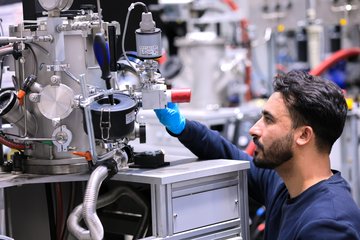All genres
61.
Journal Article
Mechanisms of subgrain coarsening and its effect on the mechanical properties of carbon-supersaturated nanocrystalline hypereutectoid steel. Acta Materialia 84, pp. 110 - 123 (2015)
62.
Journal Article
Segregation of boron at prior austenite grain boundaries in a quenched martensitic steel studied by atom probe tomography. Scripta Materialia 96, pp. 13 - 16 (2015)
63.
Journal Article
Advanced scale bridging microstructure analysis of single crystal Ni-base superalloys. Advanced Engineering Materials 17 (2), pp. 216 - 230 (2015)
64.
Journal Article
Grain Boundary Segregation in Fe–Mn–C Twinning-Induced Plasticity Steels Studied by Correlative Electron Backscatter Diffraction and Atom Probe Tomography. Acta Materialia 83, pp. 37 - 47 (2015)
65.
Journal Article
Atom probe tomography study of internal interfaces in Cu2ZnSnSe4 thin-films. Journal of Applied Physics 118 (9), 095302 (2015)
66.
Journal Article
Detection of Cu2Zn5SnSe8 and Cu2Zn6SnSe9 phases in co-evaporated Cu2ZnSnSe4 thin-films. Applied Physics Letters 107 (17), 172102 (2015)
67.
Journal Article
The maximum separation cluster analysis algorithm for atom-probe tomography: Parameter determination and accuracy. Microscopy and Microanalysis 20 (6), pp. 1662 - 1671 (2014)
68.
Journal Article
Elemental partitioning and mechanical properties of Ti- and Ta-containing Co–Al–W-base superalloys studied by atom probe tomography and nanoindentation. Acta Materialia 78, pp. 78 - 85 (2014)
69.
Journal Article
Precipitation and austenite reversion behavior of a maraging steel produced by selective laser melting. Journal of Materials Research 29 (17), pp. 2072 - 2079 (2014)
70.
Journal Article
Segregation stabilizes nanocrystalline bulk steel with near theoretical strength. Physical Review Letters 113 (10), 106104 (2014)
71.
Journal Article
Designing Heusler nanoprecipitates by elastic misfit stabilization in Fe–Mn maraging steels. Acta Materialia 76, pp. 94 - 105 (2014)
72.
Journal Article
Shear-induced mixing governs codeformation of crystalline-amorphous nanolaminates (Erratum: Physical Review Letters (2014) 113 (035501)). Physical Review Letters 113 (6), 069903 (2014)
73.
Journal Article
Atom probe tomography observation of hydrogen in high-Mn steel and silver charged via an electrolytic route. International Journal of Hydrogen Energy 39 (23), pp. 12221 - 12229 (2014)
74.
Journal Article
Grain boundary segregation engineering in metallic alloys: A pathway to the design of interfaces. Current Opinion in Solid State and Materials Science 18 (4), pp. 253 - 261 (2014)
75.
Journal Article
Shear-induced mixing governs codeformation of crystalline-amorphous nanolaminates. Physical Review Letters 113 (3), 035501 (2014)
76.
Journal Article
Crystallization, phase evolution and corrosion of Fe-based metallic glasses: an atomic-scale structural and chemical characterization study. Acta Materialia 71, pp. 20 - 30 (2014)
77.
Journal Article
Investigation of the diffusion behavior of sodium in Cu(In,Ga)Se2 layers. Journal of Applied Physics 115 (15), 154501 (2014)
78.
Journal Article
Atom probe tomography study of ultrahigh nanocrystallization rates in FeSiNbBCu soft magnetic amorphous alloys on rapid annealing. Acta Materialia 68, pp. 295 - 309 (2014)
79.
Journal Article
Atomic-scale quantification of grain boundary segregation in nanocrystalline material. Physical Review Letters 112, 126103 (2014)
80.
Journal Article
Atomic-scale analysis of carbon partitioning between martensite and austenite by atom probe tomography and correlative transmission electron microscopy. Acta Materialia 65, pp. 215 - 228 (2014)











